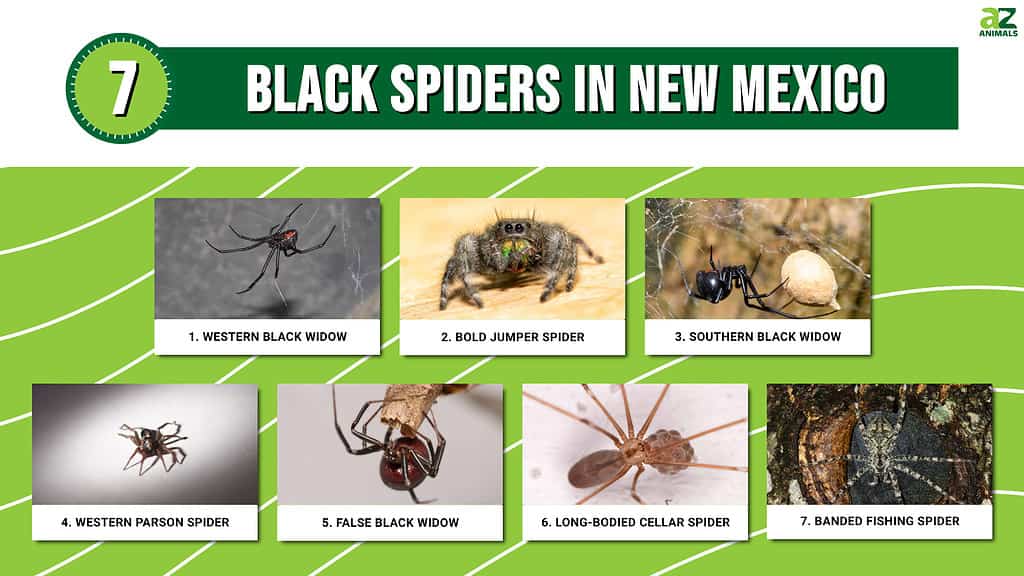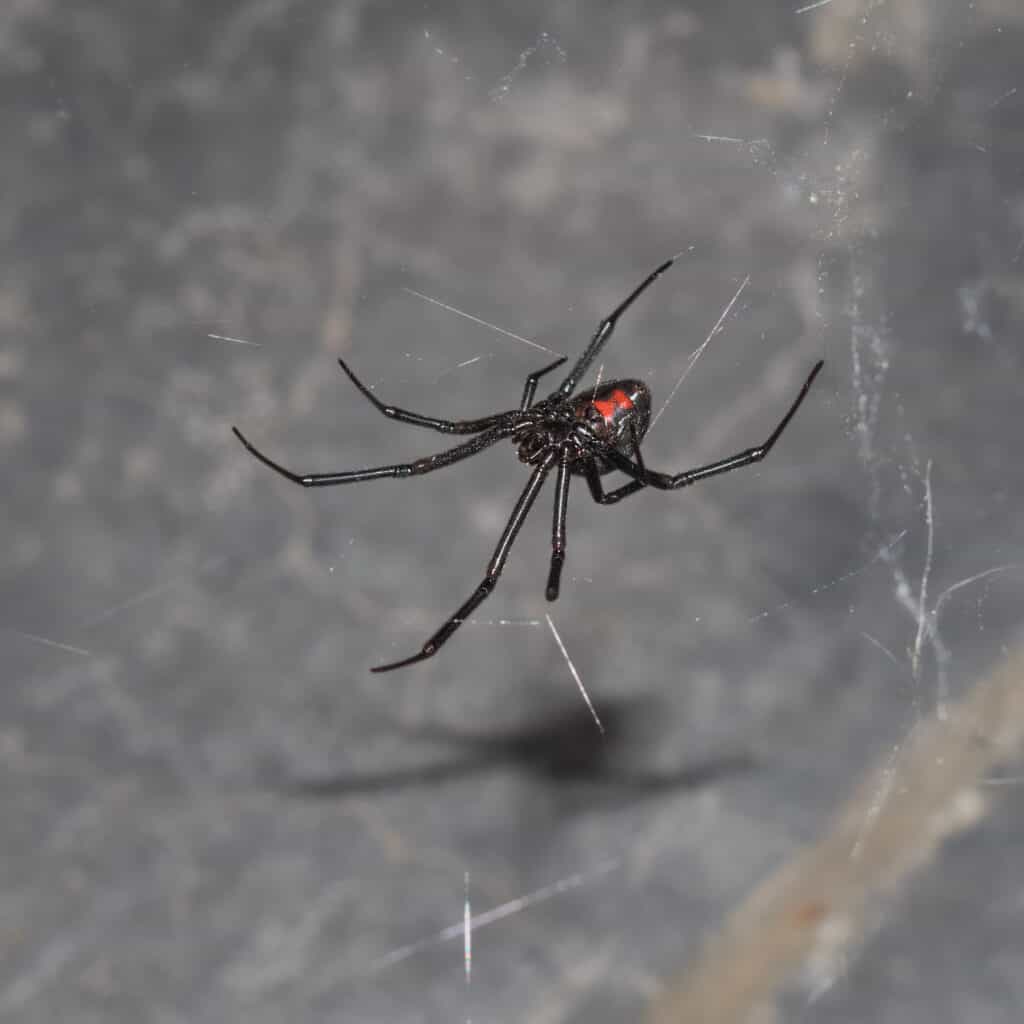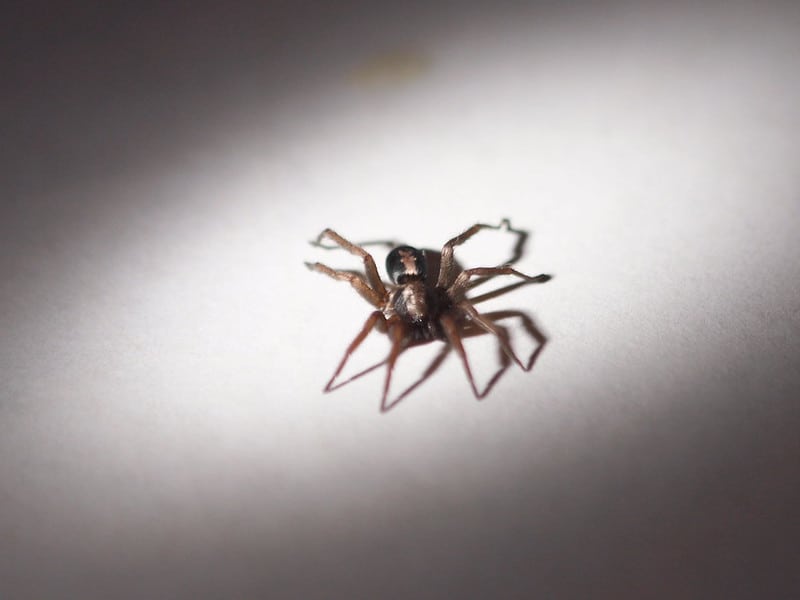Do you find creepy, furry little spiders fascinating? If so, New Mexico is the perfect place for you. This southwestern state has a great variety of spider species in its warm climate, from friendly critters to more dangerous species.

Although encountering a spider can be quite alarming, most of them are not venomous and pose no threat to people. This list is a compilation of seven spider species, alongside their associated venom intensity. Once you’re familiar with the black-bodied spiders prevalent in New Mexico, they will be easy to spot. Knowing what species are out there is the best way to overcome your fear of these often-misunderstood creatures.
1. Western Black Widow

Like most black widows, this spider has a smooth black surface and a bulging abdomen with an orange hourglass figure on its underside.
©iStock.com/Shravan Sundaram Photography
The western black widow spider is scientifically known as Latrodectus hesperus. The crawler is closely related to the southern black widow spider. The spider’s lifespan is between one to three years, and it can reach 0.5 inches in size. Like most black widows, this spider has a smooth black surface and a bulging abdomen with an orange hourglass figure on its underside. However, the spider’s hourglass mark is broken in the middle, forming triangular halves connected by red dots.
The western black widow is, in fact, the deadliest arachnid in the state of New Mexico because its venom is 15 times more potent than a rattlesnake’s venom. Moreover, the female’s poison is deadlier than the male’s. If a western black widow spider bites you, get medical attention immediately.
When the spider bites, it injects toxins into your body, triggering Latrodectism. The condition can cause stiffness of the muscles, vomiting, nausea, difficulty breathing, and excessive sweating. In extreme cases, if a victim fails to receive urgent medical care, the venom may lead to death.
Like all black widows, the western black widow females are more dominant than their male counterparts. Females have a longer lifespan and usually cannibalize males after they mate. If the females do not feed on the male widows, the males wither and die shortly after mating. The western black widow spider loves indoor spaces and incredibly dark, secluded areas.
2. Bold Jumper Spider

This spider is peculiar because it enjoys playing with humans, making it one of the best spiders to own as a pet.
©Sari ONeal/Shutterstock.com
Also known as Phidippus audax, the bold jumper is a stout-legged spider that can jump to high heights. Although the spider’s legs are short, they’re also solid and sturdy, allowing the spider to jump and land effectively.
The easiest way to distinguish the bold jumper from other spiders in New Mexico is by its distinct eyes. The spider has a large pair of eyes at the front of its head, which allows it to see better than other spiders. Also, bold jumpers have black bodies and white hairs along their leg joints. The lower part of their abdomen has three orange markings. Unlike other spiders, the bold jumper has sharp green fangs, which it uses to inject venom into its prey and immobilize it.
Instead of spinning sticky webs to capture its prey, the arachnid hunts down its target by leaping and biting them. The bold jumper’s toxin is harmless, and it rarely bites humans. This spider is peculiar because it enjoys playing with humans, making it one of the best spiders to own as a pet.
3. Southern Black Widow

Although the southern black widow can live in different habitats outside, it prefers living indoors in bleak ceiling corners, garages, and windowsills.
©Jeff W. Jarrett/Shutterstock.com
If you’ve ever seen any films or heard any pop culture references to a venomous spider, then you might be familiar with the southern black widow – scientifically known as Latrodectus mactans – one of the most famous spiders in New Mexico.
The southern black widow spider is a common inhabitant of our environment, and while its bite is potentially lethal, these spiders rarely attack unless provoked. If you inadvertently put on a shirt or shoe that contains a southern black widow, this spider may bite in defense. The southern black widow spider is known for inflicting lethal bites on people. However, it’s rare for the spider to attack unprovoked.
The spider’s maximum adult size is 0.5 inches. Southern black widow spiders can live up to three years. The spider survives by using its cobweb to trap tiny prey such as gnats or flies. The web network consists of sticky threads that trap insects, making them immobile. When the spider finds its trapped game, it poisons the prey using its venomous bite and feeds on them.
Although the southern black widow can live in different habitats outside, it prefers living indoors in bleak ceiling corners, garages, windowsills, and any parts of a house that remain undisturbed for long periods.
When breeding, the spider spurns soft sacs, which it uses to store its eggs safely after laying them. The spider then hides the eggs in its cobweb or a safe place away from predators until they hatch.
4. Western Parson Spider

It stalks its prey and evaluates their response by taunting them before attacking and killing.
©lostinfog, CC BY-SA 2.0 <https://creativecommons.org/licenses/by-sa/2.0>, via Wikimedia Commons – Original / License
The western parson spider, known scientifically as Herpyllus propinquus, is a furry, dark arachnid in various parts of New Mexico. At adult size, the spider is between 0.3 and 0.8 inches. The critter can live for two years.
You can easily recognize this spider by its white pattern, which runs down its back. The western parson spider enjoys resting throughout the day and hunting in the dark. Oddly, the critter doesn’t spin a web to catch its prey. Instead, it stalks its prey and evaluates their response by taunting them before attacking and killing. In other words, the western parson spider likes to play with its food.
Although the spider’s venom is fatal to other insects, it’s harmless to humans. The spider isn’t fond of biting people but can get aggressive if disturbed and trapped. The western parson spider’s preferred habitat is outdoors under rocks and debris or indoors in dark, bleak crevices.
5. False Black Widow

This crawler has a rounded abdomen and legs with a comb-like structure.
©Dan Olsen/Shutterstock.com
The false black widow spider is known scientifically as Steatoda grossa. The spider’s name results from the species being frequently confused for the black widow. Not only can the Steatoda grossa species survive for six years, but it can also grow to 0.4 inches. This crawler has a rounded abdomen and legs with a comb-like structure.
Unlike other black widow spiders, the false black widow doesn’t have an orange hourglass mark on its back. Also, the spider’s bite is not deadly to humans. However, the toxin has severe consequences, and symptoms may take several days to fade away without treatment.
The arachnid spins sticky webs in corners of dimly lit secluded areas to trap its prey. The spider waits outside its net for a tiny creature to get stuck in the sticky strands so that it can rush and sting the insect, thus paralyzing it. The false black widow spider can either feed on its prey instantly or stash it away to eat later.
6. Long-Bodied Cellar Spider

When an insect stumbles into the web, the spider shakes vigorously to ensure that the target becomes more entangled by the sticky strands.
©Marek Velechovsky/Shutterstock.com
The long-bodied cellar spider is commonly referred to as daddy longlegs, due to its extremely long legs, making the spider appear larger. Scientifically, the spider is known as Pholcus phalangioides. It can grow up to 0.4 inches in adulthood and live for two years.
When feeding, the long-bodied cellar spider relies on vibration signals to find its prey because it has poor eyesight. The spider spins silky tangled webs and waits for prey outside the web while hanging upside down. When an insect stumbles into the web, the spider shakes vigorously to ensure that the target becomes more entangled by the sticky strands. Long-bodied cellar spiders paralyze their victims before feeding on them.
If the arachnid feels threatened by a predator, it will vibrate its web rigorously, until the web strands become hazy. This ultimately makes it difficult for predators to spot the spider in the web, which gives the spider enough time to escape.
Its bite is harmless to humans. You can spot the long-bodied cellar spider in desolate indoor spaces like cellars, windowsills, dark ceiling corners, and isolated furniture bends.
7. Banded Fishing Spider

This spider tracks and stalks its prey on both land and water.
©iStock.com/Brett_Hondow
The banded fishing spider, Dolomedes vittatus, is a semi-aquatic spider that lives along deserted riverbanks, ponds, and streams. You can also encounter the spider in abandoned bushes, prairies, and coastal forests. The spider tracks and stalks its prey on both land and water. Instead of using webs, the critter relies on its hunting skills to trap food.
Dolomedes vittatus‘ legs appear mottled, and its surface has a white marking. The spider’s lifespan is only one year, and its maximum adult size is 1 inch.
When hunting on dry land, the banded fishing spider targets and ambushes its prey, then paralyzes it before feeding. In water, the spider depends on surface vibrations to locate its food. The banded fishing spider walks gently on the water’s surface, while listening for ripples and sounds caused by prey under the water.
The spider follows the vibrational movements to find the source and subdue the target using its venom. Once the arachnid successfully grasps its victim, it drags it back to the shore while dissolving the prey’s insides before consuming it. Sometimes, the spider chases tiny aquatic creatures like tadpoles and fish.
The banded fishing spider can survive for long periods underwater because of its lungs, which create bubbles to provide the spider with air.
What Are The Signs Of A Spider Bite?
When furry critters attack and bite, it’s usually because they feel alarmed. Although a majority of their bites are harmless, there are venomous spider species like the black widow, which can cause you to fall sick.
If you believe you’ve been wounded by the hairy crawler, here are the signs and symptoms to look out for:
- Fever
- Rashes or itching
- Difficulty breathing
- Excessive sweating
- High blood pressure
- Nausea
- Headache
- Anxiety
- Cramping or muscle pain
- Reddish or purple blister
If you have the above symptoms, we advise seeking medical treatment as soon as possible.
Can You Die From A Spider Bite?
Although it happens rarely, it’s possible to die from a spider bite. The venom can trigger symptoms of other underlying medical conditions if one does not have access to medical treatment. We recommend seeking medical care immediately in the following scenarios:
- You’re not sure whether the bite is from a poisonous spider
- The site of the sore has red lines, or you notice the redness is spreading to other parts of the body
- You’ve been bitten by a recluse spider or a black widow spider
- You’re having difficulty swallowing
- The wound appears to be growing larger
Most bites will heal if you get help on time.
If a spider attacks you or anyone nearby, it’s essential to maintain a state of calm to prevent the spider from showing additional aggression. Try to look at the creature safely to identify the species. The spider’s identity will simplify your treatment process because the doctor will know how to treat your bite.
Whatever you do, don’t try and suck out the venom using your mouth, as this may aggravate the problem. Instead, seek medical help.
How Can I Prevent Spider Bites In New Mexico?
A spider will only bite you in self-defense if provoked or trapped. While it may be impossible to predict spider bites, there are various things you can do to avoid being bitten by a spider. Such measures include:
Wear Protective Clothing
If you have a pet tarantula and are cleaning out its container, wear eye protection to prevent the creature from aiming for your eye. Also, a surgical mask will come in handy to shield your face. Tucking your pants into your socks is effective in keeping the spider from crawling up your trousers.
Keep Your Home Clean
Since most spiders love the indoors, ensure that you remove any cobwebs from your house. Avoid storing items beneath your bed because spiders can create a habitat next to them. Check if your bedding is dragging on the floor, as this could potentially provide an entryway for spiders to climb into your bed. Also, remove any debris around your home and avoid keeping firewood near your home.
Research More About Spiders
Learning details about spiders, such as what venomous spiders look like, might save your life. Find out the likely habitat of dangerous spiders in New Mexico to avoid them. We also recommend learning how to act in case you encounter a spider.
For instance, if a spider lands on your skin, avoid sudden movements that may trigger it. Don’t crush the spider against your face or your body. Instead, flick the critter away from your body with your finger.
About Black Spiders In New Mexico
Numerous spider species exist in New Mexico, most of which are non-venomous to humans. Still, we recommend exercising caution if you encounter an unfamiliar spider. Although seeing spiders is common in New Mexico, some species are so rare that you will only discover them once or twice.
Spiders can be fascinating creatures to observe. Whether small or large, these creatures vary in hunting and feeding patterns while often demonstrating an unexpectedly friendly demeanor.
Should you be fortunate enough to come across an arachnid in its environment, take a moment to appreciate it from afar. Never approach a spider, as this could result in being bitten. Promptly seek medical attention in the event of a bite to avoid any potential complications.
Summary Of The 7 Black Spiders In New Mexico
| Rank | Spider |
|---|---|
| 1 | Western Black Widow |
| 2 | Bold Jumper Spider |
| 3 | Southern Black Widow |
| 4 | Western Parson Spider |
| 5 | False Black Widow |
| 6 | Long-Bodied Cellar Spider |
| 7 | Banded Fishing Spider |
The photo featured at the top of this post is ©
Thank you for reading! Have some feedback for us? Contact the AZ Animals editorial team.







